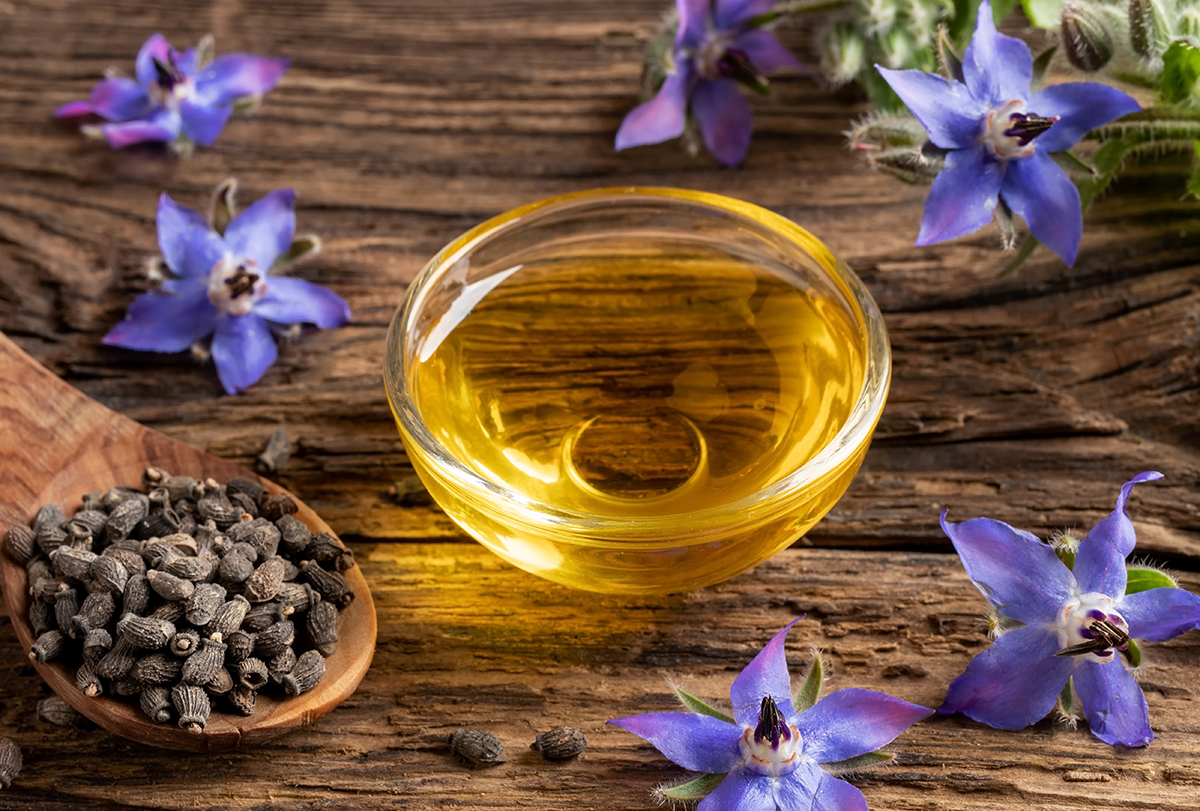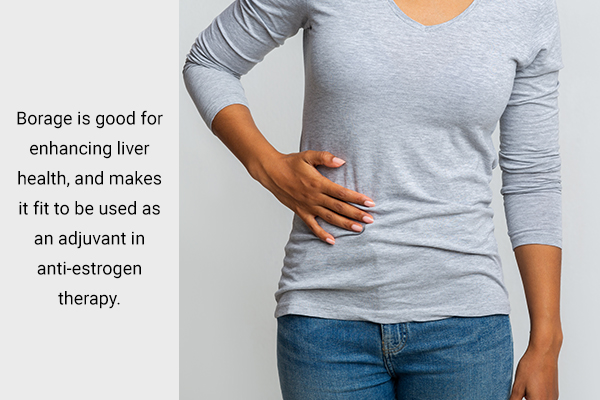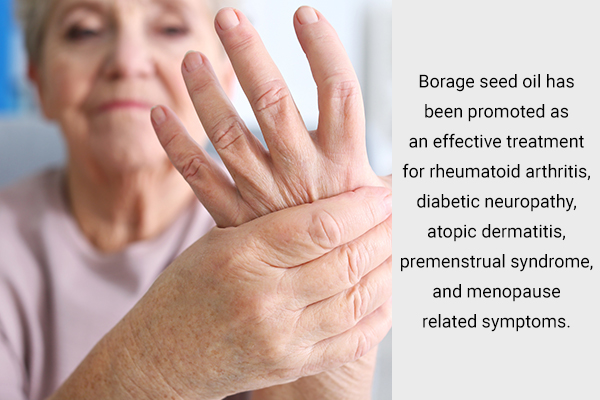In this article:
Borage oil is obtained from Borago officinalis, which is an herb commonly known as star flower. It is native to Southern Europe, North Africa, and Asia Minor, but it has naturalized in many parts of the world, including Central, Eastern, and Western Europe, as well as North America.

The flowers and leaves of borage are frequently utilized in salads and beverages because of their flavor. (1)
The borage plant’s seeds are rich sources of gamma-linolenic acid (GLA), comprising 26%–38% of the oil. This oil is often used as a dietary or food supplement and has been utilized in the treatment of multiple conditions such as diabetes, heart disease, arthritis, eczema, and multiple sclerosis. (2)
Gamma-linolenic acid can be mistaken for estrogen because it has similar effects on the body as estrogen. However, GLA is not estrogen and does not contain any actual estrogen hormones.
Because borage oil has amounts of gamma-linolenic acid, people often have a misconception that it contains estrogen, but in reality, it is only abundant in the hormone-supporting gamma-linolenic acid.
Borage oil is not estrogenic and does not raise prostaglandin levels (prostaglandins are hormone-like substances that play a role in various bodily functions), which makes it a superior option compared to other plant oils such as evening primrose oil. (2)(3)
How Does Borage Oil Support Hormonal Balance Despite Being Non-Estrogenic?
As discussed, borage oil does not contain estrogen, but it contains the hormone-promoting GLA, which is an essential omega-6 fatty acid that helps maintain cell membranes. Gamma-linolenic acid also acts as a building block for many hormones and important substances such as prostaglandins and leukotrienes. (2)(3)
GLA is held in awe for its properties such as pain-relieving and anti-inflammatory actions. GLA is inherently present in particular plants such as black currant, evening primrose, and hemp.
Even though evening primrose is a good source of GLA with 8%–10% of GLA content, it has a lesser GLA content than borage (26%–38% of GLA), because of which borage is considered one of the best biological sources of GLA. (4)(5)(6)
Balancing estrogen levels

Gamma-linolenic acid may be helpful in balancing estrogen levels to achieve estrogen dominance. This is done by reducing inflammation that arises from prostaglandins and oxidative stress by free radicals.
This action of GLA from borage is good for enhancing liver health, making GLA fit to be used as an adjuvant in anti-estrogen therapy.
In one study that included women who suffered from estrogen-sensitive breast cancer, the intake of gamma-linolenic acid supplements in conjunction with the estrogen-blocking cancer drug Tamoxifen enhanced the efficacy of the drug. (7)
Moreover, according to experts, a major reason for PMS discomfort is the lack of balance between anti-inflammatory and pro-inflammatory prostaglandins. GLA is known to transform into the prostaglandins PgE1 and PgE3, which have pain-alleviating actions, while repressing PgE2, which is a prostaglandin that causes pain.
Gamma-linolenic acid is also a wonderful agent for decreasing inflammation, which is apparent by its usefulness as a pain killer. Research has shown promising results when GLA was used for women suffering from PMS and menopausal symptoms. (8)(3)
Therapeutic Benefits of GLA From Borage Oil
Gamma-linolenic acid is often used as a supplement when taken internally and topically via oils such as borage oil. This is because of its various medical benefits.
1. Reduces inflammation
In the populace struggling from discomfort such as pain and inflammation arising from rheumatoid arthritis, borage oil and black currant oil have been studied to reduce symptoms such as: (9)(10)(11)
- Joint inflammation
- Pain
- Stiffness
2. Supports weight loss
Gamma-linolenic acid may also aid in weight loss. In one study that involved people with obesity who had lost a lot of weight, GLA was observed to establish its role in maintaining weight loss and preventing the recovery of the lost weight. (12)
3. Improves skin health
An assessment to study the use of plant oils on skin wellness and health established that GLA in borage oil, when applied topically, was beneficial in babies and youngsters with skin issues such as eczema.
This shows that the topical use of borage oil is helpful in promoting skin health by treating inflammation of skin cells. (13)
How to use borage oil on the skin:
- Purchase high-quality borage oil from a reputable source. Look for organic, cold-pressed oil to ensure that the oil is pure and free of additives.
- Cleanse your skin thoroughly. Remove any dirt or makeup on your skin.
- Apply a small amount of borage oil mixed with a carrier oil to your fingertips and massage it into your skin using gentle circular motions.
- Apply the oil evenly over your entire face, neck, and other areas of your skin.
How Do You Take Borage Oil?

You can take borage oil capsules or supplements. Before taking any dietary supplement, it is important to consult a healthcare professional. They can help you determine the appropriate dosage and whether borage oil is right for you.
You can also use natural borage leaves and flowers to brew a cup of herbal tea:
- Borage plants can be found growing in gardens or purchased at a local farmers’ market. Harvest the leaves and flowers of the borage plant when they are fresh, as they will have the most flavor and nutrients.
- Rinse the borage leaves and flowers under cool water to remove any dirt or debris.
- Bring water to a boil in a kettle or pot.
- Once the water has come to a boil, add the borage leaves and flowers to the pot. Use about 1 tablespoon of fresh leaves and flowers per cup of water.
- Cover the pot and allow the tea to steep for about 5–10 minutes, depending on how strong you like your tea.
- After steeping, strain the tea through a fine-mesh strainer or cheesecloth to remove the leaves and flowers.
- Pour the borage tea into a cup and enjoy hot or cold.
It may take several weeks or months of consistent use to see the full benefits of taking borage oil. Be patient and consistent in your use of the supplement to achieve the best results.
Who Should/Shouldn’t Use GLA?
Borage oil is generally safe for use but is not recommended by experts in several conditions. These groups of people should not use borage oil because of its high content of gamma-linolenic acid:
- GLA has a blood-thinning activity, so those who are taking blood-thinning drugs such as warfarin should only take GLA supplements after professional advice. (14)(15)
- Borage supplements may be an issue for patients taking anticonvulsant medications as well. (16)
- Pregnant women are also advised to avoid using borage. (17)
What Are the Benefits of Borage Oil Taken Internally?

Borage oil taken internally has many potential benefits due to its high concentration of gamma-linolenic acid.
Gamma-linolenic acid has been shown to have anti-inflammatory properties and may be helpful in treating various conditions, including diabetes, osteoporosis, cancer, arthritis, certain skin disorders such as atopic eczema, reproductive disorders such as breast pain and premenstrual syndrome, cardiovascular diseases, and neurological problems related to diabetes.
Additionally, borage seed oil has been promoted as an effective treatment for rheumatoid arthritis, diabetic neuropathy, atopic dermatitis, premenstrual syndrome, and menopause-related symptoms.
However, it is important to note that more research is needed to fully understand the potential benefits and risks of taking borage oil internally, and it is always recommended to consult a healthcare professional before starting any new supplement. (18)
Most-Asked Questions
Who may need to take borage for GLA supplementation?
Borage may be recommended for people with GLA deficiency such as those with:
- Old age
- Diabetes
- Malnutrition
- Inflammatory disorders
Can anyone use borage oil/take a borage supplement?
No, not everyone can take borage oil supplements. It should not be taken by those who are on blood-thinning medications or anticonvulsant drugs or are pregnant. (14)(15)(16)(17)
What is the effect of estrogen-containing oils on the body?
A popular oil known for its estrogenic activity is soybean oil. Soy isoflavones can act similarly to estrogen (a female hormone) in the body. They can fully mimic estrogen’s effects, partially mimic them, or block estrogen’s effects altogether. (19)
Eating soybeans has been shown to help with a lot of different health problems, such as heart disease, diabetes, weak bones, high blood pressure, and inflammation. Soybeans can also help women who have irregular periods or who are going through menopause by reducing symptoms such as hot flashes. (20)
Final Word
Borage oil can be a go-to source of gamma-linolenic acid, which has a ton of benefits for your body. Although borage oil is not estrogenic, its regulating actions can have beneficial effects on estrogen balance while promoting overall health.
You can use borage oil topically or take supplementation to reap its benefits.
- Was this article helpful?
- YES, THANKS!NOT REALLY


